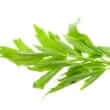Background
- Lovage (Levisticum officinale) has been used for medicinal purposes as early as the 14th century. In herbal medicine, it is used to expel flatulence (gas), induce perspiration, open obstructions, and to treat colic in children. Lovage has also been used in the treatment of jaundice, kidney stones, poor appetite, and bronchitis. Lovage has been used as a diuretic, and for regulation of menses. Aromatherapists have used the essential oil of lovage to remove freckles and spots from the face.
- Lovage is generally recognized as safe for human consumption as a natural seasoning and flavoring agent by the U.S. Food and Drug Administration (FDA). However, there are currently no well-designed human or animal studies available involving lovage.
References
- Ashwood-Smith MJ, Ceska O, Yeoman A, et al. Photosensitivity from harvesting lovage (Levisticum officinale). Contact Dermatitis 1992;26(5):356-357.
View Abstract - Bylaite E, Roozen JP, Legger A, et al. Dynamic deadspace-gas chromatography-olfactometry analysis of different anatomical parts of lovage (Levisticum officinale Koch.) at eight growing stages. J Agric Food Chem 2000;48(12):6183-6190.
View Abstract - Conway GA, Slocumb JC. Plants used as abortifacients and emmenagogues by Spanish New Mexicans. J Ethnopharmacol 1979;1(3):241-261.
View Abstract - Food and Drug Administration. Code of Federal Regulations Title 21, Volume 3. 2003. Food and Drug Administration. Code of Federal Regulations Title 21, Volume 3. 2003.
- Heck AM, DeWitt BA, Lukes AL. Potential interactions between alternative therapies and warfarin. Am J Health Syst Pharm 2000;57(13):1221-1227.
View Abstract - Podebrad F, Heil M, Reichert S, et al. 4,5-dimethyl-3-hydroxy-2[5H]-furanone (sotolone)--the odour of maple syrup urine disease. J Inherit Metab Dis 1999;22(2):107-114.
View Abstract







